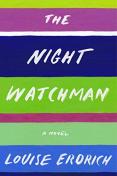
by Louise Erdrich
Hardcover- $21.97
Based on the extraordinary life of National Book Award-winning author Louise Erdrich’s grandfather who worked as a night watchman and ...
Overall rating:
How would you rate this book?
Member ratings
The Night Watchman, Louise Erdrich, author and narrator
In the novel, according to the author, Thomas Wazhashk is very loosely based on the life of her grandfather, Patrick Gourneau, who was a member of the Turtle Mountain Indian Tribe in North Dakota. He worked as a night watchman in a factory. A Chippewa Indian, he actively fought against the law intended to “terminate” the American Indians so as to remove the burden of American responsibility for their care. In the book, the Chippewa joined together, led by the character Thomas, to prevent the government from forcing them to give up their heritage and the little land they still retained. After many treaties and agreements were made and then rescinded or rolled back, they had very little land left, and they intended to keep it and their identity.
When the story begins, while Thomas fights to preserve the Chippewa, Pixie, (Patrice) Paranteau, his niece, is searching for her sister Vera who had supposedly moved off the reservation to take advantage of the government’s job training policy. She and her baby have disappeared from Minneapolis. Pixie becomes involved with some pretty unsavory characters in Minnesota, and sometimes I think her experiences pushed the envelope of belief. Pixie was portrayed as a meek, mild-mannered young woman, and then she suddenly turns into this street-wise, worldly fighter without the benefit of any experience to justify this change.
So the two themes run concurrently, Thomas Wazhashk’s efforts to thwart the American Congress’s efforts to, as he believes, “exterminate” the Indian Tribes and the effort of Pixie to find her half-sister Vera and her child. At times it seemed to ramble in its presentation in order to support one or another social or subtle political issue. The “white man” is presented in a terribly negative light as hypocritical, self-serving, highly devious and manipulative with no good intentions. The American Indian is presented as highly moral, near perfect, intelligent and G-d-fearing, always attempting to be hard working, clean, honest and upstanding, albeit with the few exceptions who appear lazy and apt to drink, coupled with those boys and bullies that took advantage of the weak, (like the government) using their power unjustly to cause harm. Sometimes superstitious beliefs seemed to control the outcome of certain events.
The author used magical realism throughout the story with thinking animals that took on anthropomorphic attributes, characters that interacted with ghosts, and characters and dogs that had psychic ability and she even endowed “old man winter” with the ability to think and act. There is definitely a spiritual thread that runs through the book that contains aspects of several religions, including the Indian’s unique faith.
The American Indians have been uprooted, slaughtered, manipulated and taken advantage of for years. The “Trail of Tears” is a testament to that. The book seems to have been intended to illustrate and illuminate that issue, as well as to point out that people have the ability to join forces and stand up together to fight the corruption of government. For me, the book itself goes off on a bit too many tangents in order to expose the abuse; however, it is a worthwhile read because it encourages further research into Native Indian history and into the issue that is the plight of many minorities today, the feeling of powerlessness. The novel takes place in 1953, and our culture, way of life and government were very different then. The ability of the strong to take advantage of those weaker, in many ways, however, remains today.
The best thing about the book is the author’s way with words, although, in this book, there may have been too many that were perhaps not well chosen, since some of the dialogue seemed childish and seemed to demean the Indian, almost making them caricatures, which I am certain was not the author’s intent.
I would say the worst thing about the novel is the author’s choice to read her own book. It is read a little too slowly and with way too much emotion which often seems inappropriate. Her voice become too sultry and soft and drones after awhile causing the listener to zone out or lose interest periodically. I was not sure I would be able to finish listening to the book, but I soldiered on because of the nature of the story, but truth be told, I hope I didn’t miss anything with my occasional lapses of interest.
Book Club HQ to over 90,000+ book clubs and ready to welcome yours.
Get free weekly updates on top club picks, book giveaways, author events and more








